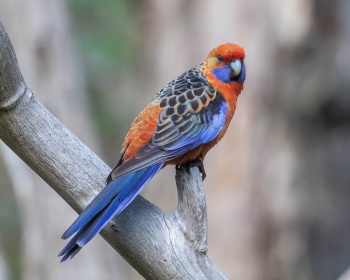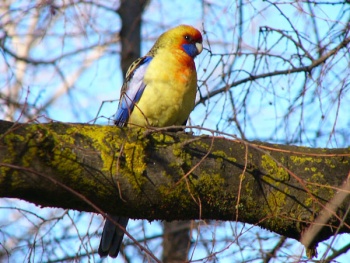- Platycercus elegans
Includes: Yellow Rosella, Adelaide Rosella
Identification

Photo © by peterday
Private garden, Normanville, South Australia, 9 January 2016
32-36 cm (12½-14¼ in)
Adult
- Crimson body plumage
- Blue cheeks
- Black back and wing coverts, edged with red
- Blue edged flight feathers
- Tail blue above, pale blue undertail
Juvenile
- Blue cheeks
- Green-olive to yellow olive body plumage (occasionally red in some areas).
Variations
Crimson Rosella subspecies P. e. nigrescens is smaller and darker.
Yellow Rosella has the crimson areas replaced with light yellow and the tail more greenish.
Adelaide Rosella is intermediate in colour, ranging from yellow with a reddish wash to dark orange.
Similar Species

Photo © by peterday
Private garden, Normanville, South Australia, 9 January 2016
Male Australian King Parrot is lacks blue cheeks, shoulders, and tail. It also has a red bill and pale eye. Immature Crimson Rosellas also differ from female and immature King Parrots by having blue cheeks, a whitish bill and a more yellow-green colouring.
Distribution
Australia: found in New South Wales, Queensland, South Australia, Victoria. Introduced to New Zealand.
Taxonomy
Yellow Rosella and Adelaide Rosella formerly considered to be separate species but now usually included in this species. Molecular studies have found P. e. nigrescens to be more distant than any of the others.
Subspecies
Seven subspecies are recognised by Clements[1]:
- P. e. nigrescens:
- Eastern Australia (coastal north-eastern Queensland)
- P. e. filewoodi:
- East central Queensland
- P. e. elegans:
- Eastern Australia (south-eastern Queensland to south-eastern South Australia)
- P. e. melanopterus:
- Kangaroo Island
- Kangaroo Island
Yellow Rosella
- P. e. flaveolus:
- Interior se Australia (Murray-Murrumbidgee river systems)
- Interior se Australia (Murray-Murrumbidgee river systems)
Adelaide Rosella
- P. e. subadelaidae:
- Southern South Australia (s Flinders Range)
- P. e. adelaidae:
- Southern South Australia (Mt. Lofty Range to Fleurieu Peninsula)
Habitat
Coastal and mountain euclypt and wet forest.
Behaviour
Diet
They eat the seeds of various trees, including native pines, blue fig, acacia and eucalyptus. Also grasses and shrubs, as well as insects and some tree blossoms. They also are readily attracted to bird seed trays.
Breeding
Using a tree hollow, the nest is lined with wood shavings and dust . The clutch contains 4-8 white eggs which are incubated by the female for about 20 days; both sexes care for the young. The young fledge after about 35 days, but depend on their parents for a further 35 days.
Vocalisation
Very vocal (often while feeding), with range of calls, the commonest being a two-syllable cussik-cussik. They also have a range of harsh screeches and metallic whistles.
Movements
Nomadic movements reported in winter at edges of range, but generally sedentary.
References
- Clements, J. F., T. S. Schulenberg, M. J. Iliff, S. M. Billerman, T. A. Fredericks, J. A. Gerbracht, D. Lepage, B. L. Sullivan, and C. L. Wood. 2021. The eBird/Clements checklist of Birds of the World: v2021. Downloaded from https://www.birds.cornell.edu/clementschecklist/download/
- Australian Museum
- Collar, N. & Kirwan, G.M. (2019). Crimson Rosella (Platycercus elegans). In: del Hoyo, J., Elliott, A., Sargatal, J., Christie, D.A. & de Juana, E. (eds.). Handbook of the Birds of the World Alive. Lynx Edicions, Barcelona. (retrieved from https://www.hbw.com/node/54510 on 18 December 2019).
- Joseph, L., Dolman, G., Donnellan, S., Saint, K.M., Berg, M.L. & Bennett, A.T.D. (2008) Where and when does a ring start and end? Testing the ring-species hypothesis in a species complex of Australian parrots. Proc. Roy. Soc. London (Ser. B Biol. Sci.) 275: 2431ñ2440.
- Eastwood, J.R. et al. (2014) Phylogenetic analysis of beak and feather disease virus across a host ring-species complex Proceedings of the National Academy of Sciences 201403255; DOI: 10.1073/pnas.1403255111
Recommended Citation
- BirdForum Opus contributors. (2024) Crimson Rosella. In: BirdForum, the forum for wild birds and birding. Retrieved 26 October 2024 from https://www.birdforum.net/opus/Crimson_Rosella
External Links
GSearch checked for 2020 platform.1






